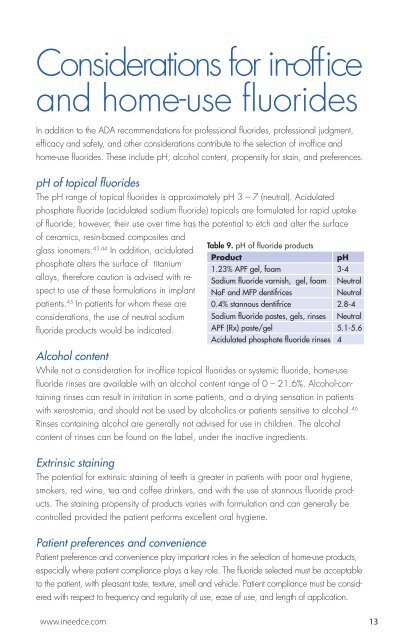You also want an ePaper? Increase the reach of your titles
YUMPU automatically turns print PDFs into web optimized ePapers that Google loves.
Considerations for in-office<br />
and home-use fluorides<br />
In addition to the ADA re<strong>com</strong>mendations for professional fluorides, professional judgment,<br />
efficacy and safety, and other considerations contribute to the selection of in-office and<br />
home-use fluorides. These include pH, alcohol content, propensity for stain, and preferences.<br />
pH of topical fluorides<br />
The pH range of topical fluorides is approximately pH 3 – 7 (neutral). Acidulated<br />
phosphate fluoride (acidulated sodium fluoride) topicals are formulated for rapid uptake<br />
of fluoride; however, their use over time has the potential to etch and alter the surface<br />
of ceramics, resin-based <strong>com</strong>posites and<br />
glass ionomers. 43,44 Table 9. pH of fluoride products<br />
In addition, acidulated<br />
Product<br />
pH<br />
phosphate alters the surface of titanium<br />
1.23% APF gel, foam 3-4<br />
alloys, therefore caution is advised with respect<br />
Sodium fluoride varnish, gel, foam<br />
to use of these formulations in implant<br />
patients. 45 In patients for whom these are<br />
considerations, the use of neutral sodium<br />
fluoride products would be indicated.<br />
NaF and MFP dentifrices<br />
0.4% stannous dentifrice<br />
Sodium fluoride pastes, gels, rinses<br />
2.8-4<br />
Neutral<br />
Neutral<br />
Neutral<br />
APF (Rx) paste/gel 5.1-5.6<br />
Acidulated phosphate fluoride rinses 4<br />
Alcohol content<br />
While not a consideration for in-office topical fluorides or systemic fluoride, home-use<br />
fluoride rinses are available with an alcohol content range of 0 – 21.6%. Alcohol-containing<br />
rinses can result in irritation in some patients, and a drying sensation in patients<br />
with xerostomia, and should not be used by alcoholics or patients sensitive to alcohol. 46<br />
Rinses containing alcohol are generally not advised for use in children. The alcohol<br />
content of rinses can be found on the label, under the inactive ingredients.<br />
Extrinsic staining<br />
The potential for extrinsic staining of teeth is greater in patients with poor oral hygiene,<br />
smokers, red wine, tea and coffee drinkers, and with the use of stannous fluoride products.<br />
The staining propensity of products varies with formulation and can generally be<br />
controlled provided the patient performs excellent oral hygiene.<br />
Patient preferences and convenience<br />
Patient preference and convenience play important roles in the selection of home-use products,<br />
especially where patient <strong>com</strong>pliance plays a key role. The fluoride selected must be acceptable<br />
to the patient, with pleasant taste, texture, smell and vehicle. Patient <strong>com</strong>pliance must be considered<br />
with respect to frequency and regularity of use, ease of use, and length of application.<br />
www.ineedce.<strong>com</strong> 13

















